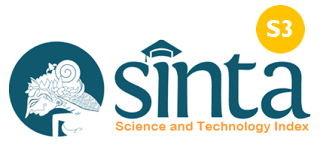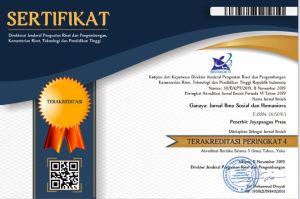Nilai-Nilai Keagamaan Dalam Novel Hasein Karya Adelia Nurrahma Dan Implikasinya Terhadap Pembelajaran Teks Novel Di SMA
Keywords:
Score, Religious Values, Novel Text LearningAbstract
The purpose of this study was to describe the religious values in the novel Hasein by Adelia Nurrahma. The object of this research is the novel Hasein by Adelia Nurrahma and this research is about religious values in the novel Hasein by Adelia Nurrahma. This type of research is a qualitative research with descriptive method. The data of this research is qualitative data, namely the data contained in words, phrases, and sentences that contain religious values in the novel Hasein by Adelia Nurrahma. The data collection techniques for this research are identifying data on characters, identifying data on events, and identifying data on religious values in Adelia Nurrahma's Hasein novel. The data analysis techniques of this research are (1) data reduction, (2) data presentation, (3) data leveraging. Based on the results of the study, the religious values contained in the novel Hasein by Adelia Nurrahma were found. First, the moral values of Islam with three indicators, namely, moral values towards Allah SWT, moral values towards oneself, and moral values towards humans. Second, the value of Islamic faith with six indicators, namely, the value of faith in Allah SWT, the value of faith in the angels, the value of faith in the holy book Al-Quran, the value of faith in prophets and apostles, the value of faith for days, the value of faith in Qadha and Qadhar.References
Abdurrahman, S. (2010). Khutbah Jum’at Amar Ma’ruf Nahi Munkar. Surabaya: Karya Agung.
Adisusilo, S. & J. R. (2014). Pembelajaran Nilai Karakter. Jakarta: PT Rajagrafindo Persada
Ancok, D. & Fuat Nashori S. (2001). Psikologi Islam. Yogyakarta: Pustaka Belajar
Asmaran. (2002). Pengantar Studi Akhlak. Jakarta: PT Raja Grafindo Persada
Gunawan, H. I. (2020). “Nilai-Nilai Religius dalam Novel Hafalan Shalat Delisa Karya Tere Liye dan Implikasinya terhadap Pembelajaran Apresiasi Sastra di Sekolah Menengah Atas”. Jurnal EDUKA Vol 5 No. 1
Isa, A. (2006). Doa-doa Pilihan: Lengkap dan Mustajab Bersumber dari Al-Quran dan As-Sunah. Jakarta: Hikmah.
Lestiasih. (2013). Nilai Keagamaan dalam Novel Kudekap Ibu di Sisi Baitullah Karya Riyanto El-Harist: Tinjauan Sosiologi Sastra dan Implementasinya pada Pembelajaran Sastra di SMA. Jurnal Artikel Publikasi
Mandzur, I. (2010). Lisanul Arab, Beirut: Darus Sodir, t.t, jilid 2.
Maududi, Abu A’la. (1986). Dasar-dasar Iman. Bandung: Penerbit Pustaka.
Muhardi & Hasanuddin W.S. (2006). Prosedur analisis fiksi. Padang: Citra Budaya Indonesia.
Nugrahani, F. & Setyani, A. (2019). Nilai Keagamaan dalam Novel Asmara di atas Haram Karya Zulkifli L. Muchdi. Jurnal Stilistika Vol 5 No.
Nugrahani, F. (2018). “Implementasi Penguatan Pendidikan Karakter Dalam Perspektif Kurikulum 2013 Pada Pembelajaran Bahasa Indonesia”. Jurnal Semnas Publikasi Hasil Penelitian Dan Pengabdian Masyarakat Vol 1 No.1
Nur Hidayah. (2018). “Nilai Keagamaan dalam Novel Titian Nabi Karya Muhammad Masykur A. R. Said”. Jurnal Locana Vol 1 No. 1
Nurgiyantoro, B. (2013). Teori Pengkajian Fiksi. Yogyakarta: Gajah Mada University Press.
Nurhasanah, E. (2018). “Analisis Unsur Ekstrinsik Novel Merry Riana-Mimpi Sejuta Dolar Karya Alberthiene Endah Dan Pemanfaatannya Sebagai Bahan Pembelajaran Bahasa Indonesia”. Jurnal Metamorfosis Vol 11 No. 1
Nurrahma, A. (2020). Hasein. Tegal: Lotus Publisher
Raharjo, H.P. & Eko Wiyanto. (2019). Mengenal Struktur Pembangun Karya Sastra. Sukoharjo: CV Sindunata
Ramadhanti, D. (2018). Apresiasi Prosa Indonesia. Yogyakarta. CV Budi Utama
Riyadi, A. (2013). “Zikir dalam Alquran sebagai Terapi Psikoneurotik (Analisis terhadap Fungsi Bimbingan dan Konseling Islam)”. Jurnal Konseling Religi Vol 4 No. 1
Safitri, V. & Candra Putra. (2021). “Nilai Religius dalam Novel Titip Rindu ke Tanah Suci Karya Aguk Irawan”. ALINEA: Jurnal Bahasa Sastra dan Pengajaran Vol 10 No. 1
Said, C. dkk. (2013). Materi Ajar Mata Kuliah: Pendidikan Akhlak dan Budi Pekerti. Padang: Jurusan Bahasa dan Sastra Inggris
Sarwat, A. (2018). Sholat Berjamaah. Jakarta: Rumah Fiqih Publishing
Stanton, R. (2019). Teori Fiksi (Terj Sugihastuti dan Rossi Abi Al Isyad). Yogyakarta: Pustaka Belajar
Sudjiman, P. (2019). Memahami Cerita Rekaan. Bandung: Pustaka Jaya
Sukardi, D. (2014). Nilai Karakter Refleksi untuk Pendidikan. Jakarta: Raja Grafindo Persada.
Sumardjo, J. & Saini K. M. (1994). Apresiasi Kesusastraan. Jakarta: Gramedia Pustaka Utama
Sumaryanto. (2019). Karya Sastra Bentuk Prosa. Semarang: Mutiara Aksara
Susilawati, E. (2017). “Nilai-Nilai Religius dalam Novel Sandiwara Bumi karya Taufikurrahman Al-Azizy”. Stilistika Vol 2 No. 1
Tjahjono, T. (2018). “Struktur Narasi dan Nilai Budaya Syair Mulan”. Jurnal Mandarin Unesa Vol 1 No. 3
Wekke, S. dkk. (2019). Metode Penelitian Sosial. Yogyakarta: Gawe Buku
Winarsih Sri. (2021). Memahami Karya Sastra Lama Indonesia. Semarang: Mutiara Aksara
Downloads
Published
How to Cite
Issue
Section
License

This work is licensed under a Creative Commons Attribution-ShareAlike 4.0 International License.
An author who publishes in the Cetta : Jurnal Ilmu Pendidikan agrees to the following terms:
- Author retains the copyright and grants the journal the right of first publication of the work simultaneously licensed under the Creative Commons Attribution-ShareAlike 4.0 License that allows others to share the work with an acknowledgement of the work's authorship and initial publication in this journal
- Author is able to enter into separate, additional contractual arrangements for the non-exclusive distribution of the journal's published version of the work (e.g., post it to an institutional repository or publish it in a book) with the acknowledgement of its initial publication in this journal.
- Author is permitted and encouraged to post his/her work online (e.g., in institutional repositories or on their website) prior to and during the submission process, as it can lead to productive exchanges, as well as earlier and greater citation of the published work (See The Effect of Open Access).
Read more about the Creative Commons Attribution-ShareAlike 4.0 Licence here: https://creativecommons.org/licenses/by-sa/4.0/.





